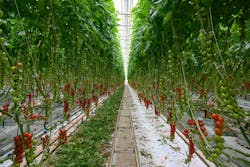Horticultural SSL news: Ontario grower boosts crop, Lumileds adds LEDs
Broad-spectrum LED lighting is gaining traction as the best option for vegetable and cannabis growing operations. An Ontario, Canada-based tomato farmer has worked with horticultural lighting in a greenhouse setting and has documented yield and biomass benefits using horticultural solid-state lighting (SSL) from Fluence Bioengineering (also referred to as Fluence by Osram). LED manufacturer Lumileds has also turned to a broad-spectrum approach in its horticultural portfolio that also includes monochromatic and phosphor-converted components.
The message on a broad-spectrum approach to horticultural lighting came through loud and clear during the keynote address at our HortiCann Light + Tech event last October. Bruce Bugbee of Utah State University said that even green spectral emission is very important to plants, despite the thinking of many that green leaves reflect that energy. And even in a region such as red, plants need more than the monochromatic red and blue horticultural fixtures deliver. Far red can promote healthier plants.
Tomato greenhouse
The principals behind Great Northern Hydroponics concur based on a decade of artificial lighting research in the commercial tomato growing facility. “We’ve been growing tomatoes for more than 20 years,” said Guido Van het Hof, president and general manager at Great Northern. “As one of the first growers in our region to illuminate crops in a commercial environment, we’ve been immersed in researching and optimizing spectral strategies for plant growth and quality. Since the onset of LED technology, I’ve been particularly curious about how broad-spectrum LEDs could affect plant development. Based on our years of research and trialing, we’ve discovered that crops grow beautifully — with higher yields and fruit weights — under broad-spectrum light.”
The grower produces 20 million lb of tomatoes annually at its 70-acre facility. Fluence recently supplied the grower with broad-spectrum fixtures covering 10 acres of the operation. Van het Hof and vice president of operation Dean Bernardes have previously utilized high-pressure sodium (HPS) legacy lighting and also the red-and-blue LED fixtures. “LED technology is proving to be superior across all categories,” said Van het Hof. “Our plants are flourishing under broad-spectrum lighting, our operational costs are decreasing, and our staff is enjoying working with white light versus harsher, redder lights. It’s a win-win for everyone.”
Worker visibility is another factor Bugbee mentioned in the HortiCann keynote address. He said workers often miss early signs of disease or insect damage under HPS or red-blue lights. And researchers are learning that spectral power distributions (SPDs) that deliver white light can be optimal for plants and workers.
Great Northern Hydroponics expects CA$150,000 (about US$118,000) in operational savings per year based on energy efficiency and reduced maintenance. The grower also earned an incentive for the installation through a utility program.
We also have another recently posted story that mentions Fluence. Parent-company Osram just announced financial results. Overall, the financial performance was moderately positive, although Fluence was noted for its recent success.
Broad-spectrum LED
Moving to the packaged LED space, Lumileds may have the broadest horticultural LED portfolio in the application sector. We covered the company’s SunPlus launch back in 2016 that included mid- and high-power LEDs in monochromatic colors, phosphor-converted colors, and phosphor-converted white. And the company has routinely added to the portfolio.
But clearly Lumileds has heard the broad-spectrum message as well. The company said there is great demand in the market for broad-spectrum white fixtures with enhanced red spectral energy. Moreover, mid-power LED packaging technology has greatly advanced in terms of reliability and such LEDs are increasingly the most cost-effective choice for horticultural applications.
So Lumileds took its workhorse Luxeon 3030 HE Plus white LED for general illumination, which has already been upgraded and optimized for maximum flux output, and customized a new Luxeon 3030 HE Plus Horticulture variant that’s hardened for what can be a challenging application environment. Specifically, the package is resistant to damage from sulfur, which can degrade many LEDs and is plentiful in a greenhouse.
A product developer specifying the new 3030 LED gets cost benefits driven by the huge epitaxial volumes in manufacturing for the general illumination market. Lumileds has characterized the new LEDs for horticultural metrics such as those specified by the DesignLights Consortium (DLC). And Lumileds has deep- and far-red monochromatic LEDs to complement the white devices.
For up-to-the-minute LED and SSL updates, why not follow us on Twitter? You’ll find curated content and commentary, as well as information on industry events, webcasts, and surveys on our LinkedIn Company Page and our Facebook page.

Maury Wright | Editor in Chief
Maury Wright is an electronics engineer turned technology journalist, who has focused specifically on the LED & Lighting industry for the past decade. Wright first wrote for LEDs Magazine as a contractor in 2010, and took over as Editor-in-Chief in 2012. He has broad experience in technology areas ranging from microprocessors to digital media to wireless networks that he gained over 30 years in the trade press. Wright has experience running global editorial operations, such as during his tenure as worldwide editorial director of EDN Magazine, and has been instrumental in launching publication websites going back to the earliest days of the Internet. Wright has won numerous industry awards, including multiple ASBPE national awards for B2B journalism excellence, and has received finalist recognition for LEDs Magazine in the FOLIO Eddie Awards. He received a BS in electrical engineering from Auburn University.





